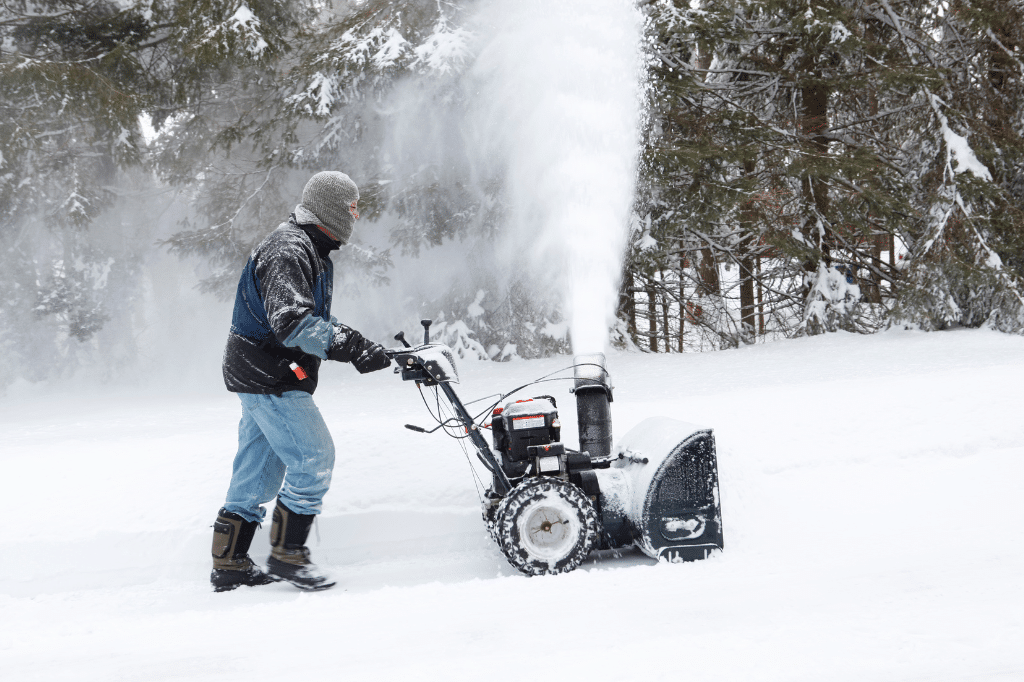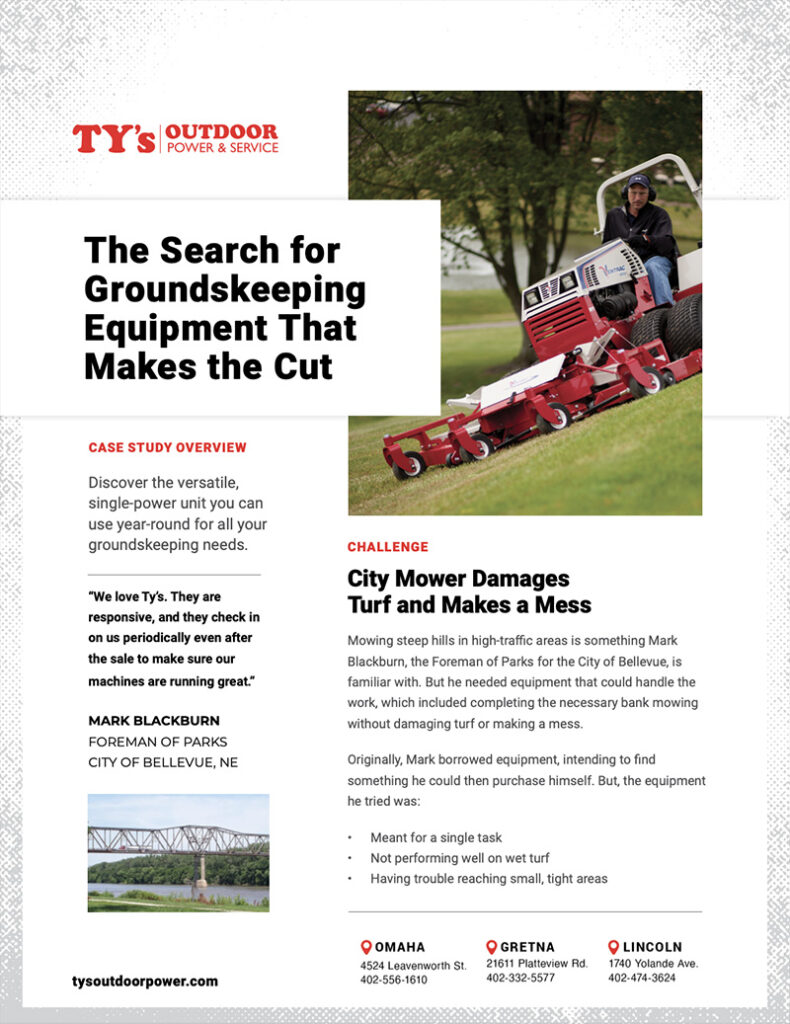It’s a fact of living in the midwest. At some point or another, you’re going to have some snow to clear. If you’re thinking about using a snow blower to make the job easier, you’ve come to the right place for some tips and tricks on how to choose, use, and maintain a snow blower like a pro.
Snow blowers come in different sizes and styles, but they all work in pretty much the same way. You’ve got an engine that powers a spinning auger, which scoops up the snow and throws it out of a chute. Before you set that machine in motion, read Ty’s ultimate guide to snow blowers!
Prepare Your Property Before the Snow Falls
Before the snow comes, start by getting your property ready so that when it’s time for snow removal, it’s faster, easier, and safer for you and the equipment.
Clear & mark the pathways:
- Pick up any toys, tools, or yard decor lying around that could get in the way.
- Put out stakes marked with florescent string to remind yourself where the paved surfaces end to prevent yourself from running the blower over your yard.
Protect your vehicle:
- Move your vehicles out of the way of your snow blower’s path. Ensure that you’ll be able to get your blower out of storage without scraping your vehicle.
Take care of your plants and trees:
- Before the snow, cover any delicate plants or landscaping objects so they don’t get damaged by the weight of heavy snow.
- After the snow, but before you run the snow blower, shake off the snow that weighs down tree branches so they don’t break. If you do this before you run your snow blower, you won’t risk dumping more snow on a freshly cleared walkway.
Don’t Wait for the Snow Storm to Stop
If you’ve got sidewalks and driveways to clear off, waiting for the snow to stop falling might seem like a good idea, but it’s a mistake. Rather than waiting for the whole storm to finish, start clearing the snow before it reaches 3-6 inches, depending on the intake height of your snow blower.
By removing the snow from your driveway in a few sessions, you’ll be able to:
- Throw the snow farther, avoiding blowback.
- Avoid creating large mounds of snow along the driveway.
- Keep a path clear for your vehicle and mail services.
- Avoid the possibility of an ice crust forming over the snow.
Throw Snow As Far As You Can – In The Right Direction
Having a snow blower can save you a lot of time when you have a large driveway or a lot of sidewalks from which to remove snow. Unfortunately, we see a lot of people fail to take advantage of the distance that a great snow blower can throw the snow. In order to maximize your time, take a few minutes to adjust your chute and check the wind direction.
Choose the Direction for Your Chute:
- Look for the adjustable chute on your snow blower.
- Turn the chute to the side where you want the snow to go.
- Make sure the area where the snow will be thrown is clear of people or cars.
Maximize Distance:
- Check the angle of the chute to make sure it’s pointing up and out, not down or in.
- Adjust the distance control on your snow blower until you see the snow predictably falling where you want it.
Don’t Forget Wind Direction:
- Take a peek at which way the wind is blowing.
- Aim the chute in the opposite direction so the wind doesn’t blow the snow back at you.
By following these simple steps, you can make sure the snow goes exactly where you want it to go, and stays there.
Don’t Bite Off More Than Your Blower Can Chew
If you’re tired of your snow blower getting clogged up every time you try to tackle a big snow pile, try a smaller “bite,” or clearing path.
Taking smaller bites of the snow can help you avoid those frustrating clogs and keep your machine running smoothly. Instead of trying to plow through a huge mountain of snow in one go, start earlier and take smaller, overlapping passes. This will put less strain on your snow blower and help prevent clogs. This will clear the snow more efficiently, and faster overall.
Don’t forget to adjust the chute direction. Aim the chute so the snow is thrown to the side, rather than straight ahead, to prevent it from getting stuck in the chute.
Snow Blower Safety Tips
Before Using the Snow Blower:
- Read the operator’s manual thoroughly.
- Wear tight-fitting clothes and sturdy boots.
- Clear the area of any potential hazards like rocks or debris.
- Check the weather conditions before you start.
During Use:
- Keep your hands, feet, and loose clothing away from the moving parts.
- Use a stick or tool to unclog the snow blower, never your hands.
- Be aware of your surroundings and watch for pedestrians or animals.
- Turn off the machine if you need to make adjustments.
After Using the Snow Blower:
- Let the machine cool down before refueling.
- Store the snow blower in a dry, secure place.
- Check for any damage and schedule maintenance as needed.
Remember, safety always comes first when using a snow blower. Don’t take any shortcuts and always use common sense. If it feels risky, it probably is.
How to Clear Snow From Gravel Surfaces
If you live on an acreage or other property with gravel surfaces, you might avoid snow blowers for your gravel surfaces in the past because you’ve heard they’ll kick up rocks and damage your property.
At the same time, shoveling out your entire lane sounds like torture. While there are other solutions, like ATV/UTV plow blades, a snow blower could still help you get your walkways and driveways cleared. The answer is a two-stage or three-stage snow blower, one that’s capable of running across the top of your gravel surfaces, removing the majority of snow while leaving your driveway intact.
The main thing to remember is that you can’t safely use a single-stage snow blower on a gravel surface. Single-stage blowers generally can’t prevent rocks from making it out through the chute and you run the risk of turning your snow blower into a rock thrower.
Choose the a Snow Blower with the Right Clearing Path
Speaking of choosing the right snow blower for your property and the type of surface you’ll be removing snow from, when it comes to snow blowers, one of the most important things to consider is the clearing path size. This refers to the width of the area that the snow blower can clear in one pass:
- 18-22 inches: Good for smaller, paved driveways and sidewalks.
- 24-28 inches: Ideal for medium-sized driveways and walkways.
- 30 inches and up: Best for larger properties and heavy snowfall areas.
Think about the size of your property, the width of the surfaces you’ll need to clear, and the amount of snow you typically get in a year. If you have a small driveway and walkway, a smaller clearing path size should work just fine.
TY’S GUIDE: Check out the Best Snow Blowers for Winter 2023-24
Single-stage snow blowers for light work
What’s a single-stage snow blower good for?
- Clearing snow that’s less than 8 inches deep
- Handling lighter, fluffier snow
- Getting the job done on smaller, level surfaces like sidewalks and decks
- Easy to maneuver and store in a garage or shed
- Great for those quick snow clean-ups
If you’re dealing with light snowfall and don’t want to break your back shoveling, a single-stage snow blower is a great investment. They’re simple to use and won’t cost you an arm and a leg.
Two-stage snow blowers for medium- to heavy-duty snows
What are two-stage snow blowers good for? Well, let me break it down for you:
- Big snow piles: Two-stage snow blowers can handle large amounts of snow, making them perfect for clearing driveways, sidewalks, and even parking lots.
- Wet and heavy snow: If you’re dealing with that wet, heavy snow that’s a real pain to shovel, a two-stage snow blower can power through it like a champ.
- Throwing distance: These machines can toss snow a long way, so you can say goodbye to pesky snow drifts and piles.
- Gravel and uneven surfaces: Two-stage snow blowers can move snow without stripping the gravel from your driveway or lane.
Three-stage snow blowers for heavy snowfalls, large properties
Dealing with heavy snowfalls can be a real pain, especially if you’ve got a large property to take care of. That’s where three-stage snow blowers come in handy. They’re the big guns of the snow blower world, designed to handle the toughest jobs.
Three-stage snow blowers are best for:
- Heavy snowfalls: When Mother Nature really dumps the white stuff on you, a three-stage snow blower can power through it like nobody’s business.
- Large properties: If you’ve got a lot of space to clear, a three-stage snow blower can make quick work of it, saving you time and effort.
- Wet, icy, or compacted snow: When the snow gets all heavy and packed down, a three-stage snow blower’s extra power and precision can help you bust through it without breaking a sweat.
- Gravel and uneven surfaces: Two-stage snow blowers can move snow without stripping the gravel from your driveway or lane.
Tips from the Service Center for Optimal Snow Blower Performance
Make sure your snow blower is ready to tackle whatever Mother Nature throws your way. To make sure your snow blower performs well all winter long, here are some top tips from our service team.
Don’t Forget Your Maintenance
- Change the oil: Just like with a car, your snow blower needs clean oil to run smoothly.
- Check the spark plug: If it’s dirty or worn out, time to replace it.
- Clean or replace the air filter: Can’t have your snow blower choking on dirty air!
- Inspect the belts and cables: Make sure everything is tight and in good shape.
- Test the auger and impeller: Are they spinning freely?
- Fill up with fresh gas: Don’t use old fuel, it can gum up the works.
Consider the Switch to Synthetic Oil
Switching to synthetic oil for your snow blower can make a big difference in how it starts and runs. Here’s why:
Better cold-weather performance: Synthetic oil flows better in cold temperatures, which means your snow blower will start easier on those freezing mornings. With conventional oil, it can thicken up and make it harder for the engine to turn over.
Reduced engine wear: Synthetic oil has special additives that help protect your engine from wear and tear, especially during those tough winter conditions. This means your snow blower will last longer and perform better.
Improved fuel efficiency: Synthetic oil can help improve fuel efficiency, which means you’ll save money on gas.
Fewer oil changes: Synthetic oil doesn’t break down as quickly as conventional oil, so you won’t have to change it as often. This can save you time and money in the long run.
So, if you want your snow blower to start easier, run smoother, and last longer, it’s worth considering making the switch to synthetic oil.
Don’t Add Fuel to a Warm Snow Blower
One thing you should always remember is to let your snow blower cool down before you add more fuel.
- Safety first: When a snow blower is hot, adding fuel can be dangerous. You don’t want any accidents!
- Prevent spills: Letting the snow blower cool off ensures that the fuel won’t spill out when you add it.
- Protect the engine: Adding fuel to a hot engine can cause damage to the engine components. Letting it cool down keeps everything running smoothly.
So, when you’re ready to gas up your snow blower, just remember to give it a little time to cool off first. It’s a simple step that can keep your snow blower working its best.
Make Sure Your Fuel is Fresh
Speaking of adding fuel, you’ll also want to make sure you always start with fresh fuel.
- Fresh fuel keeps your snow blower running smoothly
- Old fuel can clog up the engine and cause it to stall
- Using old fuel can make your snow blower harder to start
- Fresh fuel provides the best performance for your snow blower
- It helps ensure that your snow blower will start up when you need it
- Old fuel can lead to costly repairs for your snow blower
Using fresh fuel is an easy way to maintain your snow blower and keep it running for years to come.
Don’t Forget the Stabilizer
Stabilizer helps keep your fuel from breaking down and getting all gunky. That means your snow blower will start up more easily and run better. When fuel sits for a while, it can leave behind some nasty residue that clogs up your snow blower’s engine. Stabilizer helps stop that from happening.
Stay ready to go: If you use stabilizer, your fuel will stay fresh for months. That way, when the snow starts falling, you’ll be all set to clear your driveway without any problems. Adding stabilizer is a quick and easy way to prevent expensive headaches down the road.
Prevent & Check for Auger Damage
Preventing damage to your snow blower’s auger is one of the most important things you can do to extend the lifetime of your equipment. A damaged auger can also be an accident waiting to happen, so you’ll want to inspect your equipment regularly.
Watch out for:
- Excess vibration. If your snow blower vibrates a lot when in use, that could be a sign that the auger or another part is damaged.
- Diminished performance. If the snow blower doesn’t throw snow as far as it used to, there could be an issue with the auger.
- Poor handling. If the snow blower feels more difficult to handle, that could be a sign of damage to the auger or wheels.
- Grinding or new noises. Listen for any strange noises when using the snow blower. If it sounds wrong, stop.
To prevent damage to your snow blower’s auger, remember:
- Keep the auger clear of debris and clear your property of obstructions before the storm.
- Keep up with the manufacturer’s suggested maintenance schedule.
- Use the right snow blower on the right surface.
- Always be on the lookout for any worn-out or broken parts.
By keeping an eye on your snow blower and doing regular maintenance, you can prevent and catch any damage to the auger before it becomes a bigger problem.
The Right Outdoor Power for Peak Winter Performance
The experts at Ty’s Outdoor Power are always here with new tips, tricks, and guides to help you get the most out of your outdoor power. At Ty’s, we treat everyone like family. Keeping your power equipment maintained and in service is always our top priority!
Follow us on Facebook for the latest, including great deals on top equipment.


